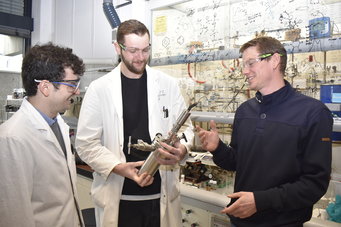Microbially induced corrosion (MIC) is a major issue in marine environments, leading to structural damage such as cracking in concrete infrastructure. This corrosion poses a persistent challenge, significantly reducing the lifespan of marine structures and resulting in substantial economic losses. In response to the need for an effective solution to combat marine corrosion in concrete, The Hong Kong Polytechnic University (PolyU) researchers have developed a biomineralisation approach to protect marine concrete from MIC.
Prof. Xiang-dong LI, Dean of the Faculty of Construction and Environment, Director of the Research Institute for Sustainable Urban Development, Chair Professor of Environmental Science and Technology, and Ko Jan Ming Professor in Sustainable Urban Development at PolyU, has led research that successfully introduced a novel biomineralisation strategy which effectively isolates marine concrete from MIC, thereby contributing to the realisation of sustainable coastal structures.
MIC in concrete usually occurs in harsh environments with the presence of corrosive microorganisms in, for example, sewage structures, wastewater treatment plants, and marine structures. The formation of a biomineralised film on concrete surfaces is typically considered to be the most effective anticorrosion mechanism as it can provide a barrier to inhibit corrosion build-up.
Prof. Li said, “Our biomineralisation technique serves as an environmentally friendly coating method for controlling concrete corrosion, with minimal impact on the overall biofilm communities. Also, it utilises carbon dioxide to produce mineral precipitates, enhancing the durability of concrete structures. This process not only reduces the carbon footprint and energy consumption of marine infrastructure throughout its lifespan, but also makes a valuable contribution to carbon neutrality and sustainability.”
The study has demonstrated that the biomineralisation treatment effectively prevents corrosion by reducing the total and relative abundance of sulfate-reducing bacteria (SRB). SRB is a type of anaerobic bacteria and can produce hydrogen sulfide, which is corrosive and can, in turn, lead to material deterioration.
The biomineralised film acts as a protective layer, controlling sulfate diffusion and isolating the concrete from corrosive SRB communities. This protective mechanism significantly extends the lifespan of concrete structures and has no negative impact on the native marine microbial communities.
Prof. Li added, “If the biomineralised film remains intact, repainting the concrete structures is unnecessary. The utilisation of a single coating treatment eliminates the need for multiple treatments, further minimising the cost and carbon footprint.”
This biomineralisation strategy has strong potential for applications in corrosive environments, such as in marine and sewage settings, and water-cooling utilities, where concrete corrosion is induced by corrosive microorganisms.
A paper reporting the research, “Biomineralisation to prevent microbially induced corrosion on concrete for sustainable marine infrastructure“, has been published in Environmental Science & Technology. The study employed a combination of chemical and mechanical property measurements of concrete, in conjunction with an analysis of the microbial community of biofilms, to evaluate the effectiveness of biomineralisation techniques in inhibiting corrosion of marine concrete. These assessments aimed to enhance understanding of MIC development. The results contribute to the development of new techniques for inhibiting corrosion to achieve sustainable marine concrete structures.
Considering that the type of colonised surface also affects the treatment effect of biomineralisation, the effectiveness of biomineralisation will be further investigated for different types of concrete to expand its potential application. In addition, functional prediction can be used in future studies to obtain a mechanistic understanding of the possible metabolic capability of microbial action on concrete corrosion. This understanding would be beneficial for uncovering the mystery of the effect of SRB on the lifespan of marine concrete structures.







